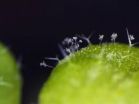(Press-News.org) This news release is available in Spanish.
CRG researchers shed new light on mitosis. The study published in the Journal of Cell Biology describes how Topo 2 disentangles DNA molecules and is essential for proper cell division
At this very moment thousands of our body's cells are duplicating and dividing. This is the mechanism by which the body repairs damaged tissues and regenerates others like skin and hair. It involves a fairly complex process known as "mitosis", during which the cell duplicates its genetic material and separates it into two identical halves, which are then split apart. It is crucially important that this process works well each and every time it takes place, as otherwise it could give rise to mutations that might trigger diseases such as cancer.
Work published today in the Journal of Cell Biology and carried out by a team of researchers from the Centre for Genomic Regulation (CRG) sheds new and revealing light on this complex mechanism. In a study using yeast, they have discovered that an enzyme known to be vital for chromosome separation, topoisomerase 2 (Topo 2), is active for much longer than was previously thought; they have also observed that chromosome length is decisive in determining the amount of time this protein works for.
Untangling chromosomes
When a cell prepares to divide, it duplicates its DNA and compacts it into pairs of identical chromosomes. However these duplicated chromosomes are twisted around each other, as if they were a tangled up pair of earphones. Before the cell is split into two, each half must receive one copy of each replicated chromosome; it is thus essential that chromosome pairs unknot or untangle properly. Otherwise, they will not be able to separate during cell division, and the DNA within could be cut or divided badly, which might lead to cell death or harmful mutations – and possibly cancer.
"To solve this problem the cell has two options: either to patiently disentangle the chromosomes, as one unties messed up cables; or to cut them up and put them back together again. For cables, especially if they are earphones wires, perhaps cutting them is not a good idea, but chromosomes are so long that there is really no other option. And this is what the cell does using Topo 2", explains Manuel Mendoza, head of the Coordination of Cytokinesis with Chromosome Segregation group at the CRG.
Topo 2 is, therefore, a molecule responsible for cutting DNA knots between replicated DNA molecules, untangling the pairs of chromosomes and closing up the cuts afterwards, so that each member of the pair of chromosomes can migrate to the opposite side of the cell as it splits in half. This role of Topo 2 has been known for some time, but it was believed that it acted quickly and equally on all chromosomes. However, Mendoza and his team suggest that this hypothesis was wrong.
The team of researchers from the CRG wanted to know if chromosome length influenced this enzyme's action at all. In principle, if the number of entanglements between the chromosomes in each cell is the same, independently of whether the chromosomes are long or short, then the time Topo2 needs to untwine them should always be the same too.
However, they have found that in cells with chromosomes that are longer than normal, Topo2 needs an extra amount of "help" to undo the knots, suggesting it has to be active for longer. To continue with the previous metaphor, apparently this molecule needs –although it is not known why- for the cables of the two earphones to be stretched until the first knot is under tension: this is when Topo2 begins to untie it. And it does this in order, knot by knot, starting with the closest to the end of the earphones and ending with the farthest away.
The "help" which Topo2 receives comes from the microtubules, a type of tiny wire that makes up part of the mitotic spindle, a structure similar to a rugby ball that is created when the cell begins the process of duplication and division. The microtubules are anchored to the chromosomes at a precise point (the centromere) and pull them apart so that one copy goes to each side of the cell. This way when it splits apart, each half will contain the same genetic information.
Mendoza explains that "surprisingly, we saw that the longer a chromosome is, the more time it takes the enzyme to unknot it completely. And we believe we understand why. As the speed at which these microtubules pull chromosomes apart is constant, when the chromosome is short, all the tangles or knots rapidly come under tension. On the other hand, if it is long, it will take more time for tension to spread through the whole chromosome", and, therefore, Topo 2 will finish to untangle them later. To understand this process better, just imagine someone trying to pick up and wrap a long rope.
According to the results of this study, the long chromosomes need more time to be disentangled than the short ones. And this untangling only occurs when the microtubules begin to stretch the chromosomes, in the period of mitosis known as 'anaphase'. Right up to this moment, Topo2 continues doing its job.
Understanding all the players in the precise mechanism of cell division helps us understand one of the most complex and repetitive processes in any organism. The correct functioning of cell division is key to the survival of every cell and, by extension, of all living beings.
INFORMATION:
Reference: Titos et al., Chromosome length and periuclear attachment constrain resolution of DNA intertwines. The Journal of Cell Biology (2014), http://doi.org/10.1083/jcb.201404039
Unraveling cell division
2014-09-16
ELSE PRESS RELEASES FROM THIS DATE:
Sam Houston State study examines use of GIS in policing
2014-09-16
HUNTSVILLE, TX (9/16/14) -- Police agencies are using Geographic Information Systems (GIS) for mapping crime, identifying crime "hot spots," assigning officers, and profiling offenders, but little research has been done about the effectiveness of the technology in curbing crime, according to a study at Sam Houston State University (SHSU).
"This review provides a reality check on the current status of GIS assessment in policing and the findings are not positive," said Yan Zhang, a SHSU professor and co-author of "Geographic Information System Effects on Policing Efficacy: ...
Do you always get what you pay for? How consumers mispredict product quality
2014-09-16
Consumers are willing to spend thousands of dollars for luxury brand watches such as Rolex and Cartier because they are synonymous with high quality. But does this mean that inexpensive watches made by low-cost rivals must always be low quality? According to a new study in the Journal of Consumer Research, consumers mistakenly predict product quality based on quality consistency in other price ranges.
"Highly consistent quality in one price range is enough for consumers to assume that quality can be predicted by price. Based on this belief, consumers assume high or low ...
Do ads showing sexy women make male consumers less charitable?
2014-09-16
What happens when you use images of sexy women to attract men's attention? According to a new study in the Journal of Consumer Research, male consumers who are shown images of sexy women feel less connected to other people and are less likely to purchase products advertised as benefiting others or make charitable contributions.
"Images of sexy women are ubiquitous in modern society and heavily used in advertising. Our primary focus is to show how exposure to pictures of sexy women could temporarily decrease the male consumer's sense of psychological connectedness with ...
Why are consumers willing to spend more money on ethical products?
2014-09-16
What motivates consumers to make ethical choices such as buying clothing not made in a sweat shop, spending more money on fair-trade coffee, and bringing their own bags when they go shopping? According to a new study in the Journal of Consumer Research, ethical consumption is motivated by a need for consumers to turn their emotions about unethical practices into action.
"Advocates of ethical consumerism suggest that consumers should consider the environmental and human costs of the products they choose, but unfortunately only a small number of people in North America ...
Exxon Valdez 2014: Does media coverage of manmade disasters contribute to consumer complacency?
2014-09-16
Twenty-five years ago, the Exxon Valdez spilled 11 million gallons of oil into Alaska's Prince William Sound. Americans found themselves cleaning up another giant oil spill in the Gulf of Mexico in 2010. According to a new study in the Journal of Consumer Research, news coverage of environmental disasters serves to calm our immediate anxieties instead of catalyzing changes in the way fossil fuels are used.
"We found that the national news media coverage of these two events helped to resolve many of the cultural anxieties that resulted, explaining what many environmental ...
Can consumers use an easy trick to extend wonderful experiences and shorten bad ones?
2014-09-16
Many experiences rarely seem to last the right amount of time. Vacations feel too short, meetings seem too long, and bad dates never seem to end. A new study in the Journal of Consumer Research finds that simply categorizing experiences can help consumers extend good experiences and shorten the bad ones.
"Consumers do not just focus on individual experiences. Instead, they categorize and manage experiences in a way that stretches out good experiences and shortens negative experiences. For positive experiences, consumers are reluctant to eliminate categories, while the ...
Lucky loyalty? Devoted consumers believe they have earned the right to win random rewards
2014-09-16
Loyal consumers can earn benefits such as frequent flyer miles or free nights at hotels when they participate in rewards programs. Loyalty, of course, doesn't increase the odds of winning random prizes or receiving random discounts. According to a new study in the Journal of Consumer Research, consumers who have shown loyalty to a company giving a random reward mistakenly believe they are more likely to receive the reward because they deserve it.
"Even though prior effort or patronage does not increase the actual likelihood of a consumer receiving promotional discounts ...
Good networkers make prime targets
2014-09-16
Proteins are responsible for practically all vital functions in an organism. For example, they catalyze metabolic reactions, forward signals, transport particular substances and control immune system responses. Researchers established some years ago that proteins do not function independently of each other, but instead form complex networks.
"When you examine the protein networks, you find many similarities with online social networks," says Dr. Pascal Falter-Braun from TUM's Chair of Plant Systems Biology. "Some proteins are good networkers that maintain contact with ...
Cancer-fighting cocktail demonstrates promising results as treatment for advanced cervical cancer
2014-09-16
DALLAS – September 15, 2014 – Combining a standard chemotherapy drug with a second drug that stops cells from dividing improves both the survival and response rates for those with advanced cervical cancer, a new study by UT Southwestern Medical Center cancer researchers finds.
The cancer-fighting cocktail, which combines the chemotherapy drug cisplatin with pemetrexed - an agent that stops cancer cells from dividing - showed promising results for advanced, persistent, or recurrent cervical cancer.
"We found that pemetrexed combined with cisplatin is less toxic, well ...
Caving to cravings? Indulging in junk food linked to lapses in brain function
2014-09-16
Overindulging in high-calorie snacks is partly caused by lapses in a very specific part of the brain, according to a new University of Waterloo study.
The study, published in Psychosomatic Medicine: Journal of Biobehavioral Medicine, is the first to conclusively link reduced operation of the dorsolateral prefrontal cortex with self-restraint in the dietary context.
"It has long been thought that the dorsolateral prefrontal cortex helps to keep automatic, or knee-jerk, reactions in check," said Professor Peter Hall, senior author on the study. "We discovered that when ...


